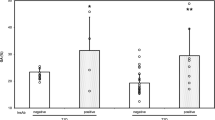Abstract
Insulin autoimmune syndrome (IAS) involves not only fasting hypoglycemia, but also postprandial hyperglycemia. In the present study, we hypothesized that glycated albumin (GA) levels and the GA/HbA1c ratio, which reflect fluctuations in plasma glucose levels, are elevated in IAS patients. Four IAS patients were enrolled in the present study. Thirty-two non-diabetic subjects matched for gender, age, and BMI were used as the control group. The fasting plasma glucose levels in the IAS patients were significantly lower than in the control group. However, the oral glucose tolerance test (OGTT) revealed impaired glucose tolerance or diabetes mellitus in all the IAS patients, and thus the OGTT 2-h plasma glucose levels were significantly higher than in the control group. The GA levels and the GA/HbA1c ratio in the IAS patients were significantly higher than in the control group, despite no significant difference in the HbA1c levels between the two groups. In one case in which IAS spontaneously went into remission, there was a significant correlation between anti-insulin antibodies and GA, but not HbA1c. Improvement in glucose fluctuations was observed by continuous glucose monitoring in another patient along with improvement in the clinical symptoms. Furthermore, anti-insulin antibodies, GA, and the GA/HbA1c ratio decreased, but HbA1c did not change significantly in three IAS patients along with the improvement in clinical symptoms. These results suggest that GA and the GA/HbA1c ratio are useful indicators for determining the level of disease activity in IAS patients.




Similar content being viewed by others
References
Hirata Y, Ishizu H, Ouchi N, Motomura S, Abe M, Hara Y, et al. Insulin autoimmunity in a case of spontaneous hypoglycemia. J Jpn Diabetes Soc. 1970;13:312–20.
Uchigata Y, Hirata Y, Iwamoto Y. Insulin autoimmune syndrome (Hirata disease): epidemiology in Asia, including Japan. Diabetol Int. 2010;1:21–5.
Koga M. Glycated albumin; clinical usefulness. Clin Chim Acta. 2014;433:96–104.
Ogawa A, Hayashi A, Kishihara E, Yoshino S, Takeuchi A, Shichiri M. New indices for predicting glycaemic variability. PLoS One. 2012;7:e46517.
Philippon M, Sejil S, Mugnier M, Rocher L, Guibergia C, Vialettes B, et al. Use of the continuous glucose monitoring system to treat insulin autoimmune syndrome: quantification of glucose excursions and evaluation of treatment efficacy. Diabet Med. 2014;31:e20–4.
Taniguchi J, Kumekawa M, Asahi N, Sato T, Ohno A, Ueki A, et al. A case of insulin autoimmune syndrome suspected of showing false positive results for insulin receptor antibody. J Jpn Diabetes Soc. 2009;52:449–55.
Nakatani Y, Banba N, Shimizu H, Momomegi N, Matsumura M, Hibi T, et al. A case of insulin autoimmune syndrome whose anti-insulin antibodies were improved by a small dose of glucocorticoid. J Jpn Diabetes Soc. 2010;54(Suppl 1):S210.
Deguchi A, Okauchi Y, Suehara S, Mineo I. Insulin autoimmune syndrome in a health supplement user: the effectiveness of cornstarch therapy for treating hypoglycemia. Intern Med. 2013;52:369–72.
Yoshino H, Kawakami K, Watanabe T, Yoshino G, Kohriyama K. A case of insulin autoimmune syndrome in an elder patient. Europ Geriatr Med. 2015;6:85–6.
Koga M, Otsuki M, Matsumoto S, Saito H, Mukai M, Kasayama S. Negative association of obesity and its related chronic inflammation with serum glycated albumin but not glycated hemoglobin levels. Clin Chim Acta. 2007;378:48–52.
Alberti KG, Zimmet PZ. Definition, diagnosis and classification of diabetes mellitus and its complications. Part 1: diagnosis and classification of diabetes mellitus provisional report of a WHO consultation. Diabet Med. 1998;15:539–53.
The Decode study group. Glucose tolerance and mortality: comparison of WHO and American Diabetes Association diagnostic criteria. Lancet. 1999;354:617–21.
Tominaga M, Eguchi H, Manaka H, Igarashi K, Kato T, Sekikawa A. Impaired glucose tolerance is a risk factor for cardiovascular disease, but not impaired fasting glucose. The Funagata Diabetes Study. Diabetes Care. 1999;22:920–4.
Author information
Authors and Affiliations
Corresponding author
Ethics declarations
Conflicts of interest
The authors declare that they have no conflicts of interest.
Human rights and informed consent
All procedures followed were in accordance with the ethical standards of the responsible committee on human experimentation (institutional and national) and with the Helsinki Declaration of 1964 and later versions. Informed consent or a substitute for it was obtained from all patients prior to their participation in this study.
About this article
Cite this article
Koga, M., Inada, S., Taniguchi, J. et al. High glycated albumin (GA) levels and the GA/HbA1c ratio in patients with insulin autoimmune syndrome. Diabetol Int 8, 199–204 (2017). https://doi.org/10.1007/s13340-016-0294-7
Received:
Accepted:
Published:
Issue Date:
DOI: https://doi.org/10.1007/s13340-016-0294-7




